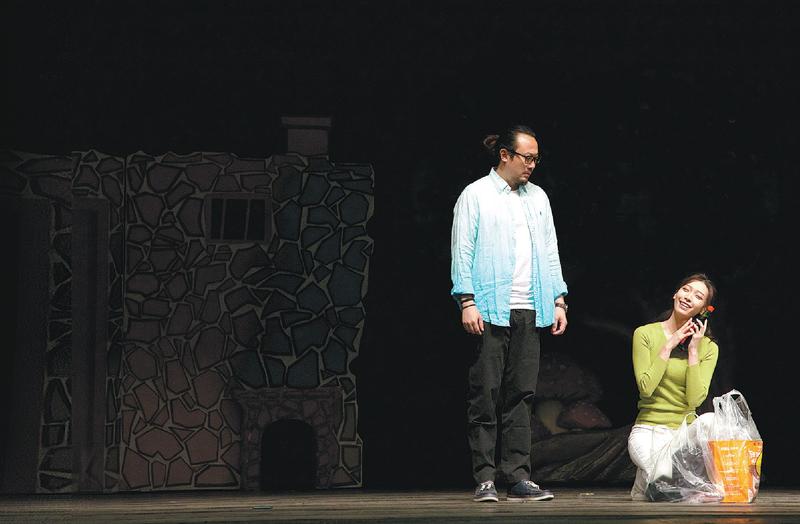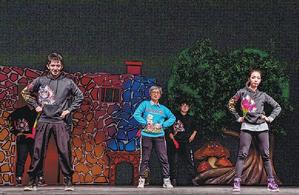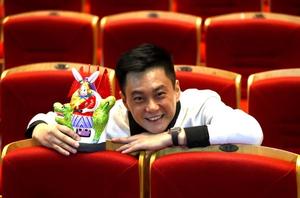Director portrays contemporary life in the capital with look at conflict between generations, Chen Nan reports.
 Scene from Beijing Tu'er Ye, a new play being staged in the capital. (PHOTO PROVIDED TO CHINA DAILY)
Scene from Beijing Tu'er Ye, a new play being staged in the capital. (PHOTO PROVIDED TO CHINA DAILY)
Actor-turned-director Wang Ban made his directorial debut in 2017 by adapting Russian playwright Nadezhda Ptushkina's work, While She Was Dying. In 2019, he directed his second play, Beyond the Horizon, adapted from American dramatist Eugene O'Neill's play of the same title.
When he considered his third play, Wang decided to tell a Chinese story, which takes place in Beijing.
The story of Tu’er Ye coincides with what we are going through now, so I rewrote the script to match the current situation
Wang Ban, director
As a veteran actor and director, who graduated from the Central Academy of Drama, Wang, 49, has been working with Beijing People's Art Theater since 1989. He is no stranger to plays centering on stories set against the backdrop of the capital since the theater is known for its plays about old Beijing, such as Teahouse and Rickshaw Boy.
However, he wanted to make something different with his own directorial work, a production which reflects the contemporary life of people living in the city.
His new play, titled Beijing Tu'er Ye, premiered on Wednesday and will be staged until Sunday at Beijing Comedy Theater.
It tells the story of a father, who is dedicated to the old art of making Tu'er Ye, small sculptures of a Rabbit God, and his son, a young entrepreneur, who owns a 3D printing store. The son doesn't understand his father's attachment to his art and wants to replace the handmade statuettes with the 3D printing technology. However, the father doesn't want to give up the traditional art and strongly disagrees with his son's ideas.
 Scene from Beijing Tu'er Ye, a new play being staged in the capital. (PHOTO PROVIDED TO CHINA DAILY)
Scene from Beijing Tu'er Ye, a new play being staged in the capital. (PHOTO PROVIDED TO CHINA DAILY)
The play shows the conflict between two generations as well as mirroring the transformation of the capital.
Tu'er Ye has become the center of Wang's play.
"I watched a TV show last year, which was about an old handicraftsman, who spent his whole life working on Tu'er Ye. His story touched me not only because of his solid techniques but also for his devotion to the traditional art. Now, many old arts like making Tu'er Ye have almost died, which is a sad thing," says Wang.
By watching the TV show, Wang also learned more about Tu'er Ye, a symbol of old Beijing. Usually sold before the Mid-Autumn Festival, it originally resembled a shrine, but gradually evolved into a toy. It is regarded as part of the folk art of Beijing. According to legend, Tu'er Ye first appeared at the beginning of the Ming Dynasty (1368-1644), and thrived in the middle of the Qing Dynasty (1644-1911).
The story intrigued Wang.
 Scene from Beijing Tu'er Ye, a new play being staged in the capital. (PHOTO PROVIDED TO CHINA DAILY)
Scene from Beijing Tu'er Ye, a new play being staged in the capital. (PHOTO PROVIDED TO CHINA DAILY)
The story goes that there was an epidemic in ancient China and doctors could not do anything about it. So the Moon Goddess sent her rabbit to Earth to treat the disease. However, because the rabbit is white, a color associated with death in the past, people did not allow the rabbit to enter their homes to treat the disease. The rabbit realized the problem and went to the temple to borrow an outfit of the saints. That's why Tu'er Ye has different outfits. Eventually, people began to revere him.
"During the coronavirus pandemic, I revised the script more than 20 times. The story of Tu'er Ye coincides with what we are going through now, so I rewrote the script to match the current situation," Wang says.
He designed a role in the play for a doctor, hoping to pay tribute to the medical workers who made great contributions during the fight against the pandemic. The director also weaves in popular topics, such as livestreaming, shopping and cosplay, hoping to attract a younger audience.
"When you watch the play, you laugh and you think afterward," Wang says.
 Director Wang Ban displays a Tu'er Ye during a rehearsal at Beijing Comedy Theater on Monday. (ZOU HONG / CHINA DAILY)
Director Wang Ban displays a Tu'er Ye during a rehearsal at Beijing Comedy Theater on Monday. (ZOU HONG / CHINA DAILY)
The cast members of the play, as Wang says, are like people living in Beijing, "They came from different parts of the country, and are considered as 'new Beijingers'."
"I can still remember that several years ago, when my little niece came to Beijing, I wanted to buy her a toy which represents Beijing. I chose Tu'er Ye because of its cute features," says Alima, who plays an online celebrity in the play. Born and raised in the Xinjiang Uygur autonomous region, the actress graduated from Shanghai Theater Academy in 2014 and came to Beijing five years ago pursuing an acting career. "I didn't know much about Tu'er Ye until the creative team of the play visited a factory, which makes them, and talked with craftsmen who still practice the old art."
Zhang Shengyao, a Beijing native, plays the role of the son. He graduated from Beijing Film Academy in 2004.
"The Rabbit God holds a special place in my heart because it symbolizes Beijing. It plays a silent role in the play, which witnesses the changes of Beijing," Zhang says.
Contact the writer at chennan@chinadaily.com.cn


